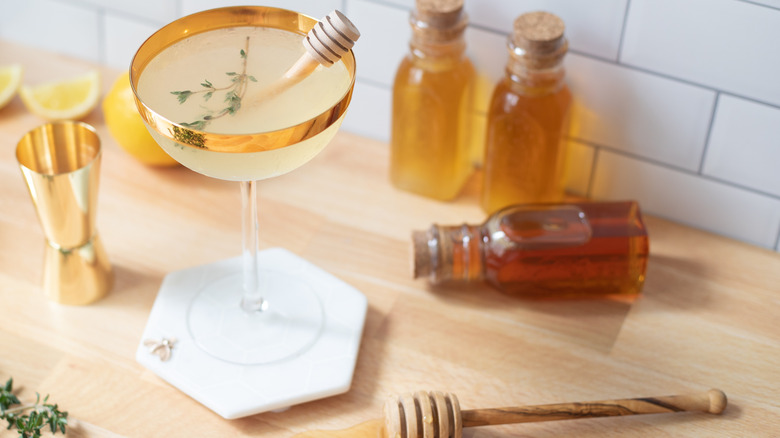The Simple Bee's Knees Variation You Need To Try
Some of the most popular cocktails out there are categorized as sours, which use only three ingredients: spirit, citrus, and sweetener. One of these, the bee's knees – made from gin, lemon, and honey syrup — has seen a resurgence. To learn about similar flavor profiles, Food Republic talked to Noemi Quatraro, head bartender at Amal in Miami, who explained how swapping the gin for bourbon in the bee's knees creates another classic cocktail, the gold rush. "The warmth and spiced notes bourbon can offer would complement the sweetness of honey," she stated, "although offering a [heavier] flavor profile to a light, gin-based drink."
Federal law requires that bourbon be made with at least 51% corn, which is a naturally sweet grain. Because of this, bourbon seamlessly marries with the sweetness of the honey while simultaneously balancing that with the alcohol's spicy kick. In contrast to bourbon, gin is powered by botanicals like juniper and coriander, as well as various types of citrus. The lemon in a bee's knees naturally complements the gin by echoing the spirit's bright, crisp quality. While a bee's knees is more refreshing and lighter, a gold rush is deeper and comforting. And, likewise, if you substitute some other spirit, you will have a new iteration.
Another bee's knees variation with tequila or mezcal
Noemi Quattro also noted that you need to be careful with your pairings: "Overall when ordering drinks that have a sweet base like honey it is important to choose wisely what liquors you're going to match them with." If you're looking to go in a completely different direction than bourbon or gin, Quatraro offered a clever twist: "With tequila and mezcal being a very popular drink of choice, swapping them out instead of gin and pairing them with agave instead of honey would also create a great riff on a classic."
Choosing the right tequila for your drink is key. Blanco, which is clear and unaged with notes that can include citrus, herbs, and vanilla, will result in a brighter cocktail. If you're more in the bourbon camp, try a reposado, whose nutty, honeyed, vanilla qualities result from aging for roughly two months to a year. Tequila is sourced only from the blue agave, but mezcal uses a broad variety of agave plants, resulting in a range of flavors from mellow to fruity to smoky.
As with tequila and mezcal, consider your agave syrup. While honey's flavor, which ranges from citrusy to floral to almost savory, agave varies based on its classification. Light agave nectar pairs well with blanco tequila because both of them are mild and somewhat neutral. On the other hand, amber and dark agave syrups are more robust and caramelly, so they naturally complement reposado tequila and also balance mezcal's smoky elements. Essentially what you're making here is a tequila or mezcal sour, putting this riff in the same class of drinks as the bee's knees and the gold rush, but with a margarita-style vibe.


